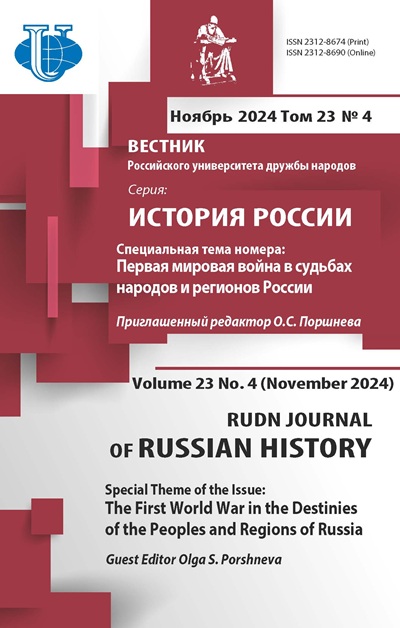Princess Anna Taishina, the First Ruler of the Stavropol Baptized Kalmyks, 1737-1742
- Authors: Dzhundzhuzov S.V.1
-
Affiliations:
- Orenburg State Pedagogical University
- Issue: Vol 21, No 4 (2022): To the 100th Anniversary of the Formation of the USSR
- Pages: 541-555
- Section: ARTICLES
- URL: https://journals.rudn.ru/russian-history/article/view/32798
- DOI: https://doi.org/10.22363/2312-8674-2022-21-4-541-555
Cite item
Full text / tables, figures
Abstract
The involvement of Kalmyk princess Anna Taishina in the process of baptized Kalmyks fitting into the economic, political and administrative-legal space of Russia is examined. Based on extensive documentary data, the author notes that the formation of a separate Kalmyk principality on the Middle Volga was the consequence of the Russian policy of Christianization and purposeful settlement of baptized Kalmyks outside the Kalmyk Khanate. The transfer of territories with a special ad-ministrative status to a sole female administration, albeit being under strict government control, is the only example in the history of Tsarist Russia. In the chronicles of the mid-1720-1730s Anna Taishina was mentioned solely in connection with the active political activities of her husband, Pyotr Taishin, and the interest of the Russian authorities in his services. A. Taishina was granted authority not due to coincidence: it was not only the unexpected death of her husband and the absence of high-born off-spring among the baptized Kalmyks, but also the desire of the Russian government to settle baptized Kalmyks in the remote territory. Within the short period of A. Taishina's reign, there were laid the foundations of the administrative-territorial structure of the Kalmyk settlement, its power structure and order of administration, economic and social development. The high legal status of the Kalmyk princess was evidenced by the transfer of the Kalmyk settlement to the Collegium of Foreign Affairs. It is confirmed that all innovations supported by the government were carried out on the initiative of Anna Taishina, or the Stavropol commandant, but always considering her opinion. The conclusion is that the order that took shape during the life of Anna Taishina set the vector for the development of the Kalmyk settlement until its abolition in 1842.
About the authors
Stepan V. Dzhundzhuzov
Orenburg State Pedagogical University
Author for correspondence.
Email: kaf_rushistory@ospu.su
ORCID iD: 0000-0001-8937-5690
Dr. Habil. Hist., Professor of the Russian History Department
19, Sovetskaya Str., Orenburg, 460844, RussiaReferences
- Bakunin, V.M. Opisanie kalmytskikh narodov, a osoblivo iz nikh torgoutskogo, i postupkov ikh khanov i vladel'tsev. Sochinenie 1761 goda. Elista: Kalmykskoe knizhnoe izdatel'stvo Publ., 1995 (in Russian)
- Dzhundzhuzov, S.V. “The revelations of the fate of the Kalmyk owner Pyotr Taishin: from the adoption of Christianity to the creation of a settlement of baptized Kalmyks in the Middle Volga region (1724-1737).” RUDN Journal of the Russian History 19, no. 3 (2020): 525-543 (in Russian)
- Dzhundzhuzov, S.V. Kalmyki v Srednem Povolzh'e i na Iuzhnom Urale: imperskie mekhanizmy akkul'turatsii i problema sokhraneniia etnicheskoi identichnosti (seredina 30-kh godov XVIII - pervaia chetvert' XX veka). Orenburg: OGAU Publ, 2014 (in Russian)
- Guriy (Stepanov). “The first Orthodox mission among Kalmyks and its practical life.” Orthodox interlocutor, no. 2 (1914): 271-327 (in Russian)
- Komissarenko, A.I. “Missionerskaia deiatel'nost' Russkoi pravoslavnoi tserkvi v XVIII v.” In Dokumental'nyi istochnik v istoricheskom issledovanii po istorii nauki: opyt ispol'zovaniia, sovremennye problemy i zadachi: k 100-letiiu so dnia rozhdeniia A.A. Zimina. Materialy mezhdunarodnoi nauchnoi konferentsii. Archive of RAS-RSUH, 476-485. Moscow: Archives of the Russian Academy of Sciences Publ., 2020 (in Russian)
- Kuznetsov, V.A. Irregulyarnye voiska Orenburgskogo kraia. Samara; Chelyabinsk: [S.n.], 2008 (in Russian).
- Orlova, K.V. Istoriia khristianizatsii kalmykov: seredina XVII - nachalo XX v. Moscow: Vostochnaia literatura Publ., 2006 (in Russian).
- Ryazhev, A.S. “The fate of the seal of the Kalmyk khan: ethno-confessional processes in the south-east of Russia in the 30-60s. XVIII century.” Bylye gody 58, no. 4 (2020): 2356-2364 (in Russian).
- Rychkov, P.I. Topografiia Orenburgskoi gubernii. Orenburg: Orenburgskoe otdelenie Imperatorskogo Russkogo geograficheskogo obchshestva, 1887 (in Russian).
- Shovunov, K.P. Kalmyki v sostave Rossiiskogo kazachestva (vtoraia polovina XVII-XIX vv.). Elista: Soiuz kazakov Kalmykii, Kalmytskii in-t. obshchestvennykh nauk Publ., 1992 (in Russian).
- Tsyuryumov, A.V. Kalmytskoe khanstvo v 1724-1741 gg.: khroniki dinastiinykh usobits. Elista: Dzhangar Publ., 2005 (in Russian).
- Tsyuryumov, A.V., and Kurapov, A.A. “Christianization of Kalmyks in Russian-Kalmyk interaction in the late 17th - mid-18th centuries.” Vestnik of Kalmyk University 48, no. 4 (2020): 38-45 (in Russian).
- Vitevskiy, V.N. I.I. Nepliuev i Orenburgskii krai v prezhnem ego sostave do 1758 g., vol. 2. Kazan: Tipo-Litografiya V.M. Klyuchnikova, 1897 (in Russian).
- Zudina, V.N., Perla N.Y. “Stavropol Kalmyks and Buddhism in the Southeastern Frontier of European Russia in the 18th-19th centuries. (On the issue of preserving traditional faith).” Bulletin of the Samara State University, no. 8/2 (2012): 87-100 (in Russian)
















